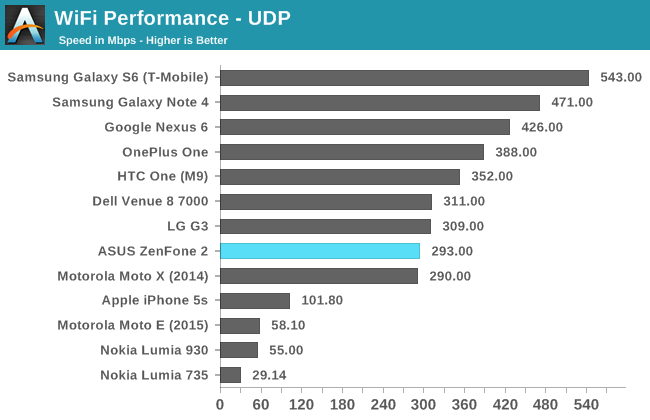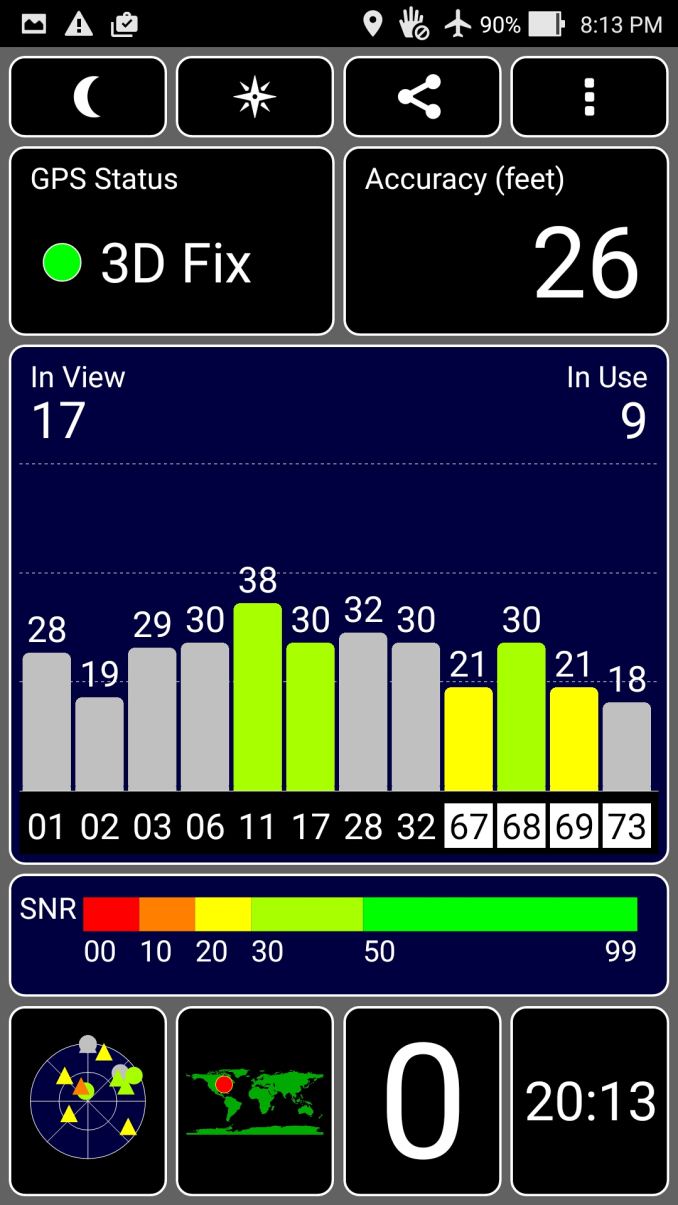The ASUS ZenFone 2 Review
by Brandon Chester on May 26, 2015 8:00 AM ESTWiFi Performance
While 802.11ac is still very much a cutting edge WiFi technology with limited adoption, it's rapidly becoming a necessity in the smartphone space just to remain competitive with the specifications of other manufacturers. Because of this, both the $199 and $299 models of the ZenFone 2 sport 1x1 802.11ac WiFi. It's funny to see this included in such an inexpensive smartphone when it's left out of $700 laptops like the ASUS UX305.
The ZenFone 2 uses Broadcom's BCM4339 WiFi + BT4.0 module. A single spatial stream 802.11ac implementation means that it's limited to a maximum speed of 433Mbps. To see how fast the ZenFone 2 can send UDP packets I've run it through our standard iPerf test for mobile devices.

Theoretical maximum speeds are rarely able to be achieved in real world testing due to interference, distance, and other factors. 293Mbps is pretty good for a 1x1 802.11ac implementation on a phone, and much better than some other inexpensive devices like the Lumia 735 which only support 802.11n. 802.11ac isn't very widely adopted yet among consumers and so I don't think ZenFone 2 users will be disappointed in their WiFi performance now or in the future.
GNSS
Thanks to a tip from a reader, I can confirm that the ZenFone 2 uses Broadcom's BCM4753. This is different from most devices which use the GNSS solution built into Qualcomm's Gobi modems. Despite this, I didn't notice any issues with the accuracy or speed of the GNSS implementation on the ZenFone 2. With GPS assistance data cleared and the device in airplane mode I was able to achieve a 3D fix in around 55 seconds. This will obviously vary depending on weather conditions, the positions of satellites, and various other factors. With GPS assistance info getting a lock took less than five seconds.











147 Comments
View All Comments
Brandon Chester - Tuesday, May 26, 2015 - link
Google Chrome is used for all of our browser tests, including battery life.re2onance - Tuesday, May 26, 2015 - link
I remember watching a review earlier about the screen being low in brightness. I thought it may have been on purpose although I assumed it was due to Asus trying to make up for the Intel SoC power consumption.I've read in the XDA forums that people experience better battery life after rooting and removing a lot of the bloatware apps, particularly the Asus built-in web browser that seems to be attached to the Trend Micro security. Honestly, people shouldn't have to root their device in order to eek out better battery life.
It seems kinda weird how Asus would spend the effort to gimp the screen from what it is actually capable of, and then fill it with apps which probably also could hinder battery life as well.
It seems like a good value phone, but the direction is all over the place.
I think the review seems fair since this is both the hardware and software Asus shipped with and updated.
T1beriu - Tuesday, May 26, 2015 - link
Brandon, could you actually disable all ASUS bloatware?I got an ASUS MeMO Pad 7 (ME572C) updated to 5.0 that looks exactly as your screenshots and I can't disable any of the useless ASUS apps.
Shame on you ASUS.
Brandon Chester - Tuesday, May 26, 2015 - link
No you can't disable all of it. I probably should have been more specific about that. You can uninstall or disable some apps such as the Apps4U apps and a few others like Omlet chat. Most of the apps that are actually from ASUS are stuck there though.ketacdx - Tuesday, May 26, 2015 - link
Hey Brandon. I thought the same but if you follow the method of holding the app in the app menu and drag it to uninstall at the top, that seems to work for most. For some reason I wasn't able to uninstall in Google Play for the same ones oddly, only disable.Brandon Chester - Wednesday, May 27, 2015 - link
That isn't working for me for apps like ZenCircle, Mirror, etc. The button to disable is greyed out.ketacdx - Thursday, May 28, 2015 - link
Yeah, I cant get those off either but it worked a lot of them thankfully. I really wish they enabled uninstall for the rest...tipoo - Tuesday, May 26, 2015 - link
"In the case of the ZenFone 2, we see that it lasts exactly as long as the HTC One (M9). Last run GPU performance is noticeably slower though."But isn't that just the relative performance difference between the two GPUs? I guess I still don't really understand the last run GPU framerate metric, shouldn't it be as a proportion of the first run framerate to mean anything? If one device performs at 100, another performs at 50, and the final runs of both are 50, the final run FPS would appear the same, but the second device didn't throttle at all while the first throttled by half.
Does the test already take this into account?
SHartman1976 - Tuesday, May 26, 2015 - link
I think you guys need to rerun the Nexus 6 battery benchmarks with 5.1 - the experience of myself and many others regarding N6 battery life is nothing like what you found on the initial 5.0 review.Brandon Chester - Wednesday, May 27, 2015 - link
I just finished re-testing the Nexus 6 on 5.1 and it lasted for 7 hours and 24 minutes in our browser test which is a worse result than the initial review. It's a small enough difference that I'll attribute it to battery degradation and/or test variance, but the point is that it hasn't improved at all.